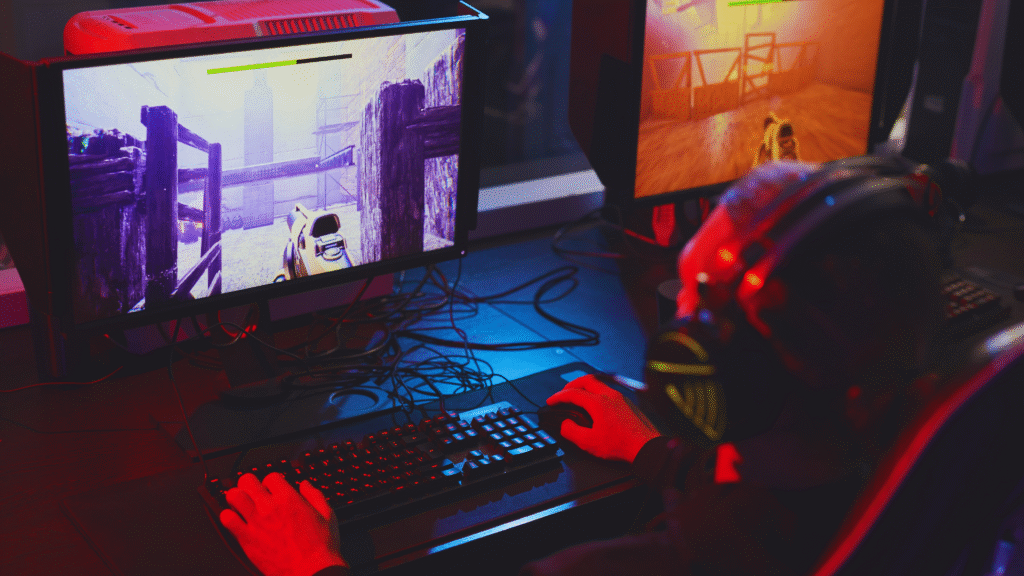Ray tracing has become a transformative technology in the gaming industry, especially in the context of next-generation games. It simulates the behaviour of light in a realistic manner, enhancing visuals and creating immersive environments. This technique allows for unprecedented levels of detail, bringing shadows, reflections, and global illumination to life in ways that were previously unimaginable in gaming.
As developers harness the power of ray tracing, players can expect to see sharper visuals that elevate their gaming experiences. The technology is not merely an upgrade; it fundamentally changes how players interact with virtual worlds, making them appear more like reality. Upcoming titles showcase this capability, promising stunning graphics that engage players like never before.
With the growing adoption of ray tracing, the line between gaming and cinematic experiences continues to blur. Developers are now challenged to push the boundaries of creativity while utilising this powerful tool. The future of gaming looks brighter, with ray tracing setting the stage for visually captivating adventures.
Fundamentals of Ray Tracing in Gaming
Ray tracing represents a significant advancement in graphics technology, enhancing visual fidelity in gaming. This section explores the mechanics behind ray tracing, and its fundamental components, and highlights the differences between ray tracing and traditional rasterisation.
How Ray Tracing Technology Works
Ray tracing simulates the way light interacts with objects to create realistic images. It begins by casting rays from the viewpoint of the camera into the scene. These rays track how they interact with surfaces, including reflections, refractions, and shadows, to produce high-quality visuals.
In real-time applications, such as gaming, this process occurs rapidly to maintain smooth performance. Advanced algorithms help optimise the computations involved, ensuring that even dynamic scenes can be rendered with great accuracy. Technologies like NVIDIA’s RTX provide dedicated ray tracing capabilities, allowing for these calculations to occur within a reasonable timeframe.
Key Components: RT Cores, GPUs, and CPUs
The effectiveness of ray tracing is heavily reliant on specific hardware components designed to support its demanding requirements.
- RT Cores: Integrated into modern GPUs, such as the NVIDIA GeForce RTX series, RT cores accelerate ray tracing calculations, significantly improving performance without sacrificing quality.
- GPU: The Graphics Processing Unit is essential for rendering complex images efficiently. It works in tandem with RT cores to handle both traditional rasterisation and real-time ray tracing.
- CPU: The Central Processing Unit supports the overall game logic and data management, coordinating between the GPU and other system components. While not specialised in graphics rendering, it plays a crucial role in-game performance.
Ray Tracing vs. Traditional Rasterisation
Rasterisation has been the cornerstone of graphics rendering for decades. It converts 3D models into 2D images but often struggles with accurately simulating light interactions. Unlike rasterisation, ray tracing excels in producing lifelike reflections, complex shadows, and global illumination.
Key Differences:
- Light Simulation: Ray tracing calculates light paths, producing more realistic effects compared to rasterisation’s approximations.
- Performance: Traditional methods can be faster but may result in visual artefacts, while ray tracing requires more computation power but offers superior realism.
Despite its advantages, the two techniques are often used in tandem, with rasterisation handling the bulk of rendering while ray tracing enhances certain aspects for improved visual fidelity.
Ray Tracing’s Impact on Next-Gen Visual Fidelity
Ray tracing significantly enhances visual fidelity in next-generation games by providing more realistic graphics and improved textures. Its capabilities allow for advanced effects in reflections, lighting, and shadows, which create immersive gaming environments.
Realistic Reflections and Refractions
Ray tracing enables true-to-life reflections by simulating the way light interacts with surfaces. Unlike traditional rasterisation techniques, which often use screen-space reflections, ray tracing captures reflections from the entire environment.
This technology also excels in handling refraction, which is the bending of light as it passes through transparent materials. Objects viewed through glass or water exhibit realistic distortions, enhancing the overall immersion. As a result, players experience environments that feel more authentic and visually striking.
Advanced Lighting and Global Illumination
Global illumination is a core advantage of ray tracing, as it calculates how light bounces and interacts with surfaces. This results in more dynamic and natural lighting conditions within game worlds.
With ray tracing, light sources illuminate scenes with greater depth, casting realistic hues and gradients. This capability allows for scenes that shift seamlessly from bright to dark areas, simulating how light behaves in the real world. Enhanced lighting leads to an improved perception of space and atmosphere in games.
Dynamic Shadows and Ambient Occlusion
Ray tracing revolutionises shadow rendering through dynamic shadows that respond accurately to light sources. Unlike static shadows that can look flat and unconvincing, ray-traced shadows exhibit soft edges and varied darkness based on proximity to light sources.
Ambient occlusion, another critical feature, enhances depth perception in environments by simulating the soft shadows that occur in corners and crevices. This effect grounds objects within their environments and adds realism to the overall visual composition.
Enhanced Texture and Visual Effects
Ray tracing contributes to improved textures by allowing intricate details to be rendered more accurately. The interplay of light and materials results in surfaces that appear more lifelike, displaying subtle nuances such as glossiness or roughness.
In addition, ray tracing supports advanced visual effects such as realistic lens flares and bloom effects. These enhancements work together to create a more captivating visual experience that keeps players engaged. Such detailed graphics elevate game art direction beyond previous limitations.
Performance Considerations and Technologies
Ray tracing enhances visual fidelity, but it poses performance challenges in next-gen gaming. Developers implement various technologies and methods to optimise performance without sacrificing graphics quality.
Optimising Frame Rate and Responsiveness
Maintaining a stable frame rate is crucial for an immersive gaming experience. Frame rates of 60 FPS or higher are desirable, especially in competitive settings. Techniques such as reduced ray tracing intensity and adjustments to detail levels can help achieve this.
Using NVIDIA Reflex can further improve responsiveness, minimising latency between input and screen action. This is vital for fast-paced games where every millisecond counts. Balancing ray tracing settings with other graphical features ensures smooth gameplay, even in graphically demanding scenarios.
DLSS, Frame Generation, and Super Resolution
Deep Learning Super Sampling (DLSS) is a transformative technology that enhances performance by rendering frames at a lower resolution and then upscaling them. DLSS 2.0 and DLSS 3 improve quality and frame rates significantly, allowing games to run at higher resolutions without a hefty performance drop.
Game developers incorporate these technologies alongside advanced anti-aliasing techniques to reduce jagged edges while maintaining clarity. The combination of DLSS with ray tracing enables higher-quality visuals at 1080p, 1440p, or 4K resolutions without overwhelming the hardware.
Performance Modes for Different Resolutions
Next-gen consoles often feature performance modes to optimise for various resolutions and frame rates. A performance mode might target 60 FPS at 1440p, while a quality mode enhances visuals at 4K, often yielding 30 FPS.
Players can choose modes based on their preferences, balancing performance against graphical fidelity. These performance modes are essential for utilising the full capabilities of the hardware, especially on powerful GPUs designed for high-end gaming experiences.
Hardware Requirements and Compatibility
To fully leverage ray tracing and associated technologies, robust hardware is necessary. High RAM capacity and powerful GPUs are essential for smooth operation at various resolutions. NVIDIA’s latest graphics cards are optimised for ray tracing, enabling seamless gameplay alongside features like DLSS.
Compatibility with existing setups is crucial. Gamers should ensure their systems meet or exceed recommended specifications, focusing on refresh rates and power consumption. Understanding these requirements helps players make informed decisions about upgrades for optimised performance and visuals.
Ray Tracing in Modern and Upcoming Games
Ray tracing is revolutionising the visual fidelity of modern games. This technology enhances realism by simulating how light interacts with objects. Notably, several titles have begun integrating ray tracing, affecting both gameplay and player immersion dramatically.
Showcase Titles: Cyberpunk 2077, Control, and The Witcher 3
Cyberpunk 2077 exemplifies ray tracing’s impact, providing stunning reflections and realistic lighting. Players can witness dynamic shadows and enhanced global illumination, significantly elevating the game’s dystopian environment.
Control was among the first to utilise ray tracing, showcasing advanced reflections and shadows. This integration not only improved visual effects but also contributed to the game’s haunting atmosphere.
The Witcher 3 recently received an update that enabled ray tracing, further enhancing its already rich landscapes. The improved lighting effects make the game’s environments feel more alive, drawing players deeper into Geralt’s world.
Integration in Game Engines: Unreal Engine and Unity
Unreal Engine has embraced ray tracing, offering comprehensive support for developers. This engine facilitates advanced lighting models and reflections, allowing creators to produce breathtaking visuals.
Unity has also made strides in ray tracing integration, enabling developers to enhance scene quality. Its flexible architecture provides tools for real-time ray tracing that significantly benefit gameplay experiences as seen in titles like Shadow of the Tomb Raider and Metro Exodus: Ultimate Edition.
Both engines facilitate unprecedented levels of immersion through intricate interactions between light and materials, pushing the boundaries of visual storytelling.
Ray Tracing on Consoles: PlayStation 5 and Xbox Series
Both the PlayStation 5 and Xbox Series prominently feature ray tracing capabilities. These consoles are designed to deliver next-gen gaming experiences, allowing developers to leverage ray-traced visuals without compromising performance.
Games such as Cyberpunk 2077 and Control run smoothly on these consoles, showcasing how ray tracing can enhance console gaming. The technology enables players to experience console titles with graphics closer to high-end PC levels.
This shift brings console gaming to new heights, allowing more players to appreciate advanced graphical fidelity.
The Future of Immersive Gaming Experiences
As technology progresses, ray tracing is poised to further transform gaming experiences. Upcoming titles are expected to integrate even more sophisticated lighting and rendering techniques.
Developers are keen to explore how ray tracing can enhance storytelling through stunning visuals and immersive environments. As adoption expands, players can anticipate increasingly lifelike graphics that will redefine what is possible in gaming.
The journey towards fully immersive gaming is just beginning, and ray tracing stands at the forefront of this evolution.

